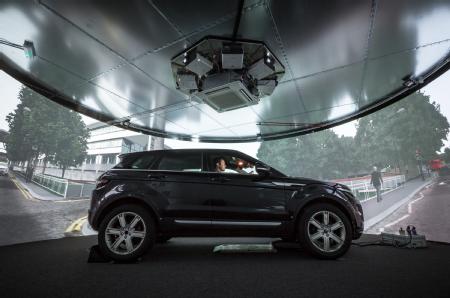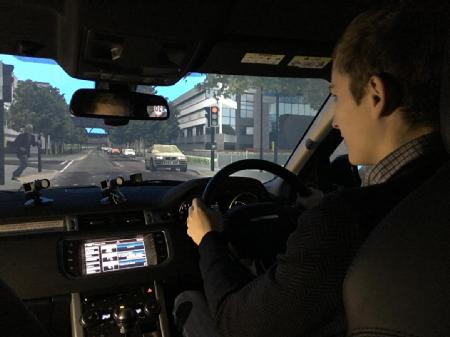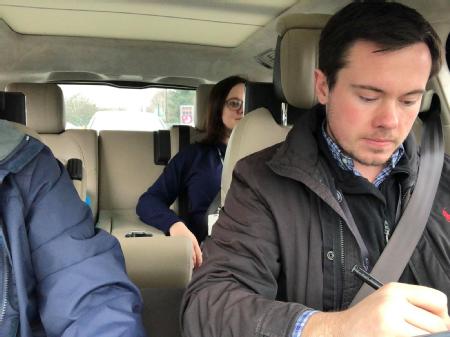ALKS cannot be on roads by Spring if a sufficient Driver State Monitoring system is not in place
The Government released a call for evidence for the safe use of Automated Lane Keeping Systems (ALKS) in August this year ready for Spring 2021. ALKS would mean drivers could use a conditionally automated system that can take over control of the vehicle at low speeds, keeping it in lane on motorways.
Joseph Smyth, from the Intelligent Vehicles group at WMG, University of Warwick has been working with the Chartered Institute of Ergonomics and Human Factors (CIEHF), to create a response to the call for evidence in regards to the human side of using ALKS technology.
In order for the vehicle to hand control back to the driver there must a criteria for a safe operation to do so, and some degree of driver state monitoring will be required, which researchers at WMG are currently investigating.
Joseph Smyth, from WMG, University of Warwick explains:
“Currently, there is no consensus about the most appropriate driver state monitoring (DSM) system that is effective in real-world situations. The government are advised to invest in research to set minimum system performance requirements for a DSM system.
“Currently, manufacturers use various techniques including eye tracking, head movement, steering wheel input and others – none of which have been proven to be fully suitable for the proposed technology. As, for example, eye tracking wouldn’t work if the driver was wearing sunglasses, and even if there was a sufficient DSM system there may be issues around how the data is collected and handled.
“The collection and storage of driver state data is important for understanding liability in the case of an accident. However, the public must be actively engaged with the government and automotive legislators to enable transparency in what data will be collected and stored – especially if we are talking about driver-focused cameras.”
The CIEHF team have also found that there is not enough research around the human machine interface (HMI) – the relationship between the vehicle and the driver – and the government should seek to set standards around the design of these so that manufacturers can adhere to at least the minimum requirements for safe operation.
Driver training is proposed for the safe operation of automated vehicles, however training should not make up for poor design – reaffirming the responsibility of human factors engineers for the safe use of these systems.
There is also concern for how an automated vehicle would respond when encountering a ‘blue light’ police or enforcement vehicle, therefore researchers urge the government to provide resource for evidence within this domain.
Many questions were raised by the researchers, including:
• What is the optimal method (including practicalities for on-road vehicles) to measure driver availability and attentiveness?
• What is an appropriate transition demand sequence and how should interaction with primary vehicle controls (steering wheel, brake pedal etc.) impact the handover of vehicle controls?
• What are the HMI requirements for communicating information pertinent to a transition demand?
• What are the training requirements and impact of training for safe operation of a Level 3 system?
• How should an automated vehicle (with automated driving system engaged) respond to an emergency response vehicle – including HMI and vehicle-driver communication?
• What tasks are appropriate to perform whilst a Level 3 system is activated and how do tasks impact the ability of the driver to safely regain control of a vehicle during a transition demand?
• Does enabling non-driving related tasks whilst in ‘automated mode’ increase likelihood or intention to engage with such tasks whilst driving manually?
WMG, University of Warwick are already researching many area around these questions, and hope to solve them to enable safe and trustworthy CAVs on the roads.
Their work includes leading the Midlands Future Mobility CAV testbed, which will test CAVs in real world settings, and can therefore be used to research concerns in many of the questions highlighted
However there are some safety implications highlighted that may require research in labs before going on real roads, this can be done by using driving simulators, such as the 3xD simulator at WMG, University of Warwick which provides the perfect test bed for this research.
In fact the UK public are invited to get involved with the development of future vehicle technology and can sign up to register interest for future user trials at this link: https://warwick.ac.uk/fac/sci/wmg/research/cav/projects/mfm/register/
Dr Joseph Smyth from WMG, University of Warwick comments:
“Although our review highlights many issues when it comes to the rollout of ALKS technology, it is also positive, as our proven expertise in future vehicles and bespoke research facilities are helping to shape the UKs direction for future automotive technology”
Dr Noozaman Rashid from the Chartered Institute of Ergonomics and Human Factors comments:
“Human factors has a long and established history in enabling safe automation in industries such as aerospace and nuclear – many of the lessons learned are transferable to automotive, but we also identify new challenges. Through engaging academic experts such as those at WMG, as well as industry practitioners and automotive professionals we, as an institute, are working to help solve some of the challenges of future mobility”
ENDS
6 NOVEMBER 2020
NOTES TO EDITORS
High-res images available at:
https://warwick.ac.uk/services/communications/medialibrary/images/june2016/wmg54.jpg
Caption: WMG 3xD simulator
Credit: WMG, University of Warwick
https://warwick.ac.uk/services/communications/medialibrary/images/september_2020/epsrc_photo.jpg
Caption: WMG 3xD simulator
Credit: WMG, University of Warwick
https://warwick.ac.uk/services/communications/medialibrary/images/october_2020/sim_vadim.jpg
Caption: Vehicle mounted eye tracking for automated vehicle research being tested in the 3xD simulator at WMG, University of Warwick
Credit: WMG, University of Warwick
https://warwick.ac.uk/services/communications/medialibrary/images/september_2020/52337591_2304204529905382_6680415677209116672_n.jpg
Caption: On-road experimentation
Credit: WMG, University of Warwick
https://warwick.ac.uk/services/communications/medialibrary/images/september_2020/img_8887.jpg
Caption: Simulator Experimentation
Credit: WMG, University of Warwick
Report available to view at: https://www.ergonomics.org.uk/Public/News_Events/News_Items/CIEHF_response_to_ALKS_consultation.aspx
For further information please contact:
Alice Scott
Media Relations Manager – Science
University of Warwick
Tel: +44 (0) 7920 531 221
E-mail: alice.j.scott@warwick.ac.uk
For further information please contact:
Alice Scott
Media Relations Manager – Science
University of Warwick
Tel: +44 (0) 7920 531 221
E-mail: alice.j.scott@warwick.ac.uk
